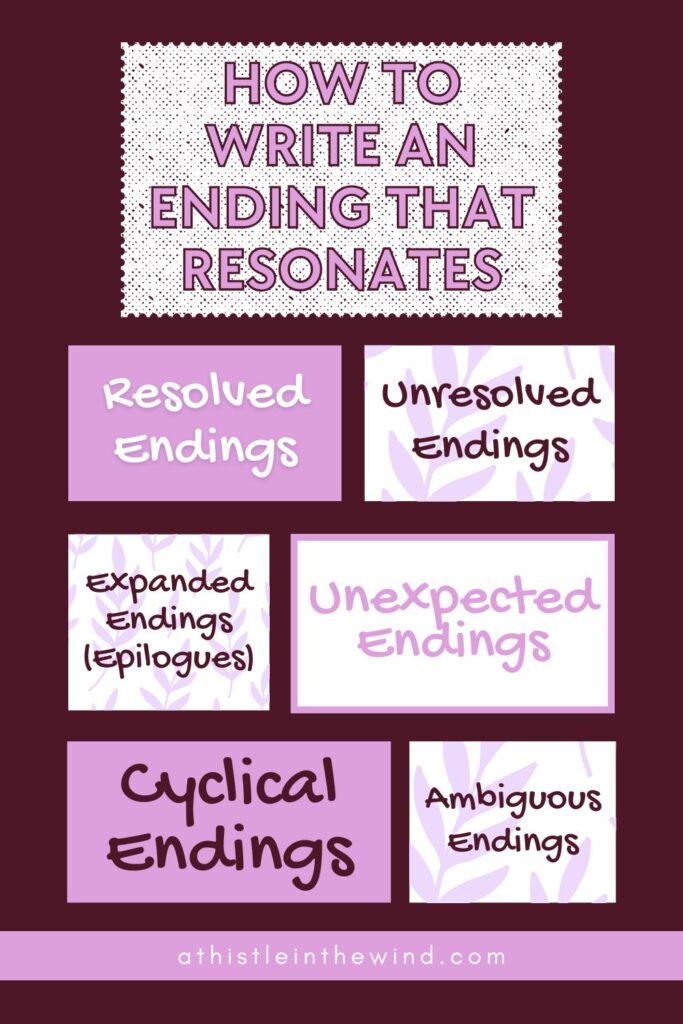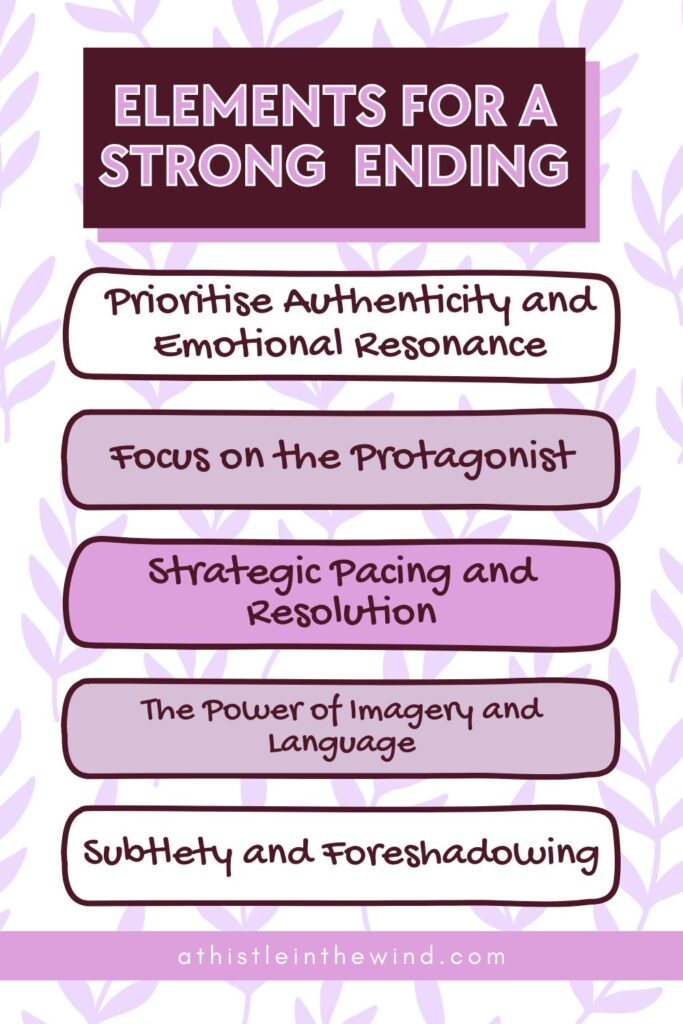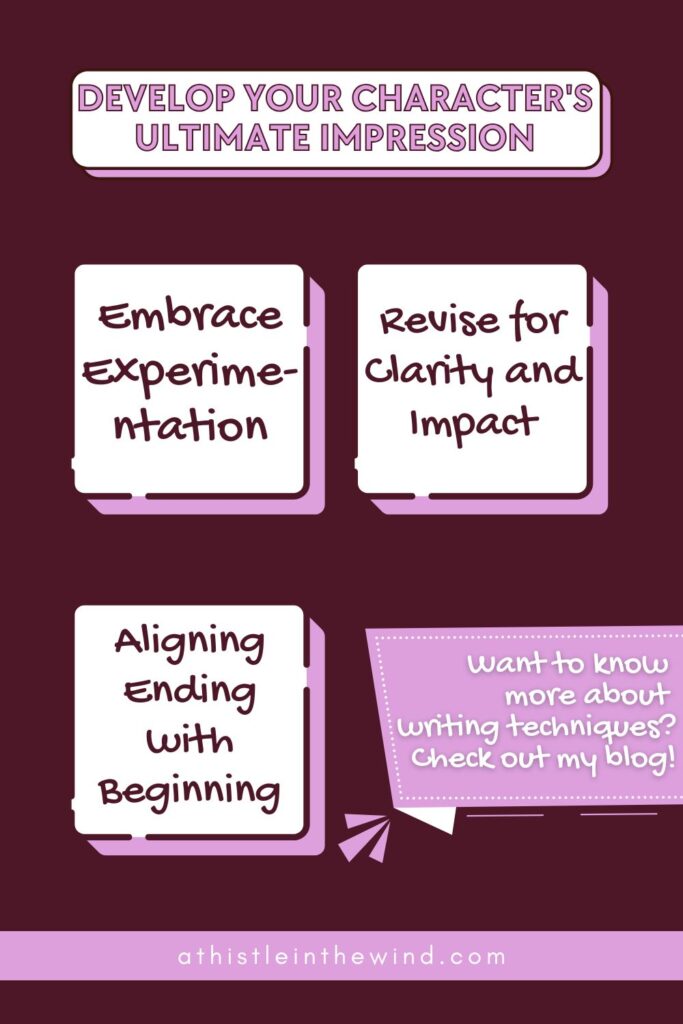How to Write Effective Endings

To quote Chuck Shurley from Supernatural:
“Endings are hard. Any chapped-*** monkey with a keyboard can **** out a beginning, but endings are impossible. You try to tie up every loose end, but you never can. The fans are always gonna *****. There’s always gonna be holes. And since it’s the ending, it’s all supposed to add up to something. I’m telling you, they’re a raging pain in the ***.”
And yes, I was a Supernatural fan in my teens (part of the SuperWhoLock part of Tumblr). We’re keeping it PG for the kids right now. In case there’s any here.
But the point is, writing endings can be difficult. Especially if you’ve poured your heart and soul into creating your characters, intricate plot lines and more. After all, it’s no secret that while a strong beginning might hook a reader, it’s the journey and, most importantly, the ending that truly makes your story memorable.
I mean, think about it: the last moments of a story are forever etched into a reader’s mind. If the ending sucks, your readers will always remember it as being disappointing. Or—and I shudder at this one—bad. Like really, really bad.
So, let’s avoid this and learn more about writing endings today.
Why Endings Define Character Perception
The ending of your story is more than just a stopping point; it’s the ultimate conclusion for your characters. It’s the reader’s final experience, the taste that lingers long after the book is closed.
This means the ending holds a lot of power in shaping how your audience ultimately feels. In fact, if the ending doesn’t quite hit the mark, the entire story can lose its staying power, regardless of how brilliant the beginning or middle might have been.
Your readers aren’t just engaging with fictional characters who vanish once the final sentence is read. Instead, the language and resolution you write can subtly hint at what might await your main characters in the future. This prompts readers to contemplate their destinies long after they’ve finished the last page.
This lingering contemplation is where the real magic happens.
What to Aim For When You’re Writing an Ending for Your Story
- A Lasting Impression: The ending of your story is the last thing your readers will encounter and reflect upon. It’s what they’ll savor, perhaps even study, to grasp the full meaning of the narrative. This final moment is likely to stay with them longer than any other part of the story, making it crucial for defining how your characters are perceived.
- Emotional Investment: Readers dedicate considerable time and emotional energy to a narrative. They journey alongside your characters, facing their triumphs and tribulations. The ending serves as the payoff for this investment, and it simply must feel earned and satisfying. If a character’s final state, whether triumphant or tragic, feels unearned, it can lead to profound disappointment.
- Beyond the Page: Characters don’t merely dissolve into nothingness after the last line. A well-crafted ending suggests their continued existence, inviting your readers to ponder their ongoing lives, their choices, and the person they have become. This imaginative engagement with their future plays a significant role in solidifying their place in the reader’s heart, or their memory as a truly dreadful individual.

Don’t Underestimate the Power of Your Character’s Journey
At the heart of every compelling story is the character’s journey: the growth, struggle, and change. The way your characters evolve (or notably fail to evolve), impacts how readers perceive them by the time they reach the conclusion.
Embrace Your Character’s Journey
The most powerful stories feature characters who are permanently changed by their experiences. They are not the same individuals they were at the beginning; circumstances have altered them “forever.” This transformation is a reflection of the lessons they’ve learned and the growth they’ve undergone, bringing their character arc to a complete and satisfying close.
The most authentic endings often arise naturally from the discovery of different facets of your characters as they develop and respond to their situations. There’s a distinct pleasure in witnessing your characters surprise you, making fitting, yet unanticipated, choices that feel honest and real because of their organic development.
When a character moves from one state of being to a fundamentally altered one—-perhaps from a closed-off, selfish individual (think Ebenezer Scrooge from A Christmas Carol) to someone open-hearted and generous—their journey towards this final state dictates how endearing or admirable they become.
This shift in their personality by the story’s end is what truly defines their likeability.
The Impact of Unchanged Characters
Sometimes, a character is given every opportunity to change or choose the right path and yet they fail. This lack of development can be incredibly potent, adding significant depth and meaning to the narrative.
Consider someone like Homelander or The Deep (or what we’ve seen so far) from the TV show, The Boys. These guys are presented with chances to gain insight and grow but ultimately fail to embrace that opportunity. This resistance to change, or an inability to overcome fundamental flaws, can lead to a conclusion where the character remains trapped in their initial state.
Such an outcome can acquire added significance, highlighting a tragic flaw or a deliberate refusal to adapt. It can make a character highly frustrating, pitiable, or even intensely hateable. The power here lies in the stark reality of stagnation, making the character’s unwavering nature a central theme of their ultimate perception.
Want to learn about making your characters likeable? Check out my blog: How to Write More Likeable (or Unlikeable) Book Characters.
How to Write an Ending that Resonates
Of course, there’s no single formula for a great ending. But there are various types of resolution archetypes you can use from existing literature to shape it. Seriously, the best stories often employ one of these or the other. You can use these to build the right ending for your story.
1. Resolved Endings
A resolved ending, often a popular and well-loved choice, leaves no loose ends. All plot points are neatly tied together, and the fates of your characters are clearly explained. You don’t have to wonder what happens next because everything is laid out with satisfying clarity.
This type of conclusion can bring immense satisfaction to readers who seek a sense of completion.
For characters, it means their final state—whether happy, tragic, or somewhere in between—is unambiguous. If your intention is for readers to cheer for a character’s hard-won happiness or grieve their definitive loss, a resolved ending delivers that clarity, closing the door on speculation.
2. Unresolved Endings
An unresolved ending deliberately leaves some elements hanging, posing more questions than it answers. Of course, while an unresolved ending could offer some resolution to the immediate conflict, it intentionally leaves certain doors open.
This can be a perfect technique if you’re writing a series, as it creates anticipation and excitement for future installments. However, it requires careful execution. You need to strike a balance between leaving readers wanting more and preventing frustration.
The goal is to make them excited about the characters’ future, rather than annoyed by a lack of closure. This method ensures your characters remain vibrant and active in the reader’s imagination, keeping their story alive.
3. Ambiguous Endings
I’ll admit that this is my favourite type of ending. It’s very different from an unresolved ending, an ambiguous conclusion is open to interpretation. This type of ending is ideal if you want your readers to reflect deeply on the themes of your story and the nature of your characters. It doesn’t provide a definitive “right or wrong” answer and invites speculation and personal engagement.
An ambiguous ending can make characters incredibly memorable.
However, there’s a risk of frustrating readers who crave certainty. So, it’s best to make this choice when you are confident in your ability to deliver an ending that encourages meaningful contemplation rather than confusion.
4. Unexpected Endings
An unexpected or surprising ending twists the narrative in a direction the reader didn’t see coming. This is often a staple in mystery or suspense, where the audience is led to believe one outcome, only for a shocking revelation to redefine everything.
For this to work effectively, the twist must make sense in hindsight. You need to subtly lay groundwork and plant clues throughout the story that, while not obvious at first, become clear upon reflection. George R.R. Martin does this really well, by the way.
Adding subtle clues makes this type of ending feel inevitable rather than “out of nowhere” and leaves readers feeling clever for having missed the signs.
An unexpected ending can dramatically reshape how a character is perceived. A seemingly good character might be revealed to have dark motivations, or a reviled one might be shown in a new, sympathetic light. This kind of ending can either intensify a character’s likeability or make them hateable actually by revealing a hidden, sinister nature.
5. Cyclical Endings
A tied or cyclical ending brings the story full circle, concluding right where it began. This approach often highlights a character’s journey by revisiting their starting point. But this time, with a wealth of new context gained from the entire narrative.
The setting or situation may be the same as the beginning but the characters are not. This type of ending is powerful for demonstrating growth (or the poignant lack thereof). It invites readers to compare the character at the beginning to their state at the end.
The cyclical structure emphasizes on how a character has arrived at their final juncture in life. It allows readers to appreciate the depth of their experience and how that has ultimately shaped who they are.
6. Expanded Endings (Epilogues)
An expanded ending, typically in the form of an epilogue, jumps forward in time to reveal what happens to the main characters and the world of the story far beyond the immediate conclusion of the main plot.
Epilogues offer readers a satisfying window into the characters’ future lives, tying up threads that couldn’t be resolved within the main narrative. They can provide a sense of realism, suggesting that life continues for these characters long after their central conflict is over.
For characters, an epilogue offers a final impression of their legacy, their long-term happiness, or the consequences of their actions. However, it’s crucial that your epilogue enhances, rather than replaces, your ending, offering deeper insights. It should not be compensating for a weak conclusion.

Essential Elements for a Strong Character-Driven Ending
Writing an ending that leaves a lasting impression on your readers requires careful attention to several key elements.
1. Prioritise Authenticity and Emotional Resonance
Don’t rush the final scenes of your story. Allow the ending to develop organically, much like your characters themselves. Remarkable endings feel honest and real because they emerge naturally from the narrative. Your readers have invested heavily in your characters’ journey, and they deserve a proper payoff, not a rushed conclusion.
Your ending should evoke the feelings you intend—be it happiness, sorrow, anticipation, or something more complex. To achieve this, the emotional state of your characters at the conclusion must be genuinely earned through the preceding events. If the build-up to the final moments is solid, the ending will resonate deeply and feel authentic.
Ultimately, if the ending moves you as the writer, it will undoubtedly move your readers. Think about the emotional impact you want to leave. Each choice profoundly impacts how characters are remembered.
2. Focus on the Protagonist
No matter the complexity of your plot or your cast, the ending belongs to your main character. The story is, at its core, about them, and their arc must take centre stage in the final moments.
The protagonist should be the one to perform the pivotal action or face the ultimate consequence that brings the story to its climax. This final display solidifies their journey, demonstrating how they have changed into the person they’ve become.
Avoid shifting the spotlight to secondary characters at the very end, as this can dilute the impact of your protagonist’s resolution and leave readers feeling unsatisfied.
3. Strategic Pacing and Resolution
A truly satisfying ending doesn’t cram all revelations into the last few pages. Instead, resolve some of the smaller plot points in the chapters leading up to the climax, saving the most meaningful and full-circle developments for the very end. This allows each resolution to breathe and feel more impactful.
Knowing when to stop is also a crucial skill. An exhilarating resolution can lose its punch if the story drags on unnecessarily. The best finales often strike their emotional note and then gracefully conclude. While some ambiguity can be powerful, be careful not to leave too much unsaid, as this can leave readers feeling cheated or frustrated. Trust your readers to connect the dots, but ensure that the central conflicts are resolved to a satisfying degree.
To learn more about pacing, check out my blog: On the Art of Pacing: A Writer’s Guide.
4. The Power of Imagery and Language
The imagery and language you choose for your ending can influence how readers perceive your characters’ future and their current psychological state. Rich, evocative language offers a wealth of possibilities for interpretation, deepening the reader’s understanding of your characters.
Consider how carefully chosen words can predict a character’s future or imply their inner turmoil. Imagery can also compel readers to recall earlier instances in the narrative, reinforcing the strongest moments from the story. Instead of an ending that dictates a single interpretation, language rich with suggestion invites readers to ponder.
5. Subtlety and Foreshadowing
Give your readers credit; avoid spelling everything out or laboring your points. Be subtle in the conclusions you want them to draw about your characters’ ultimate states. Show, don’t tell is excellent advice, especially for an ending.
If you plan a twist that reveals a new facet of a character, or a significant, yet unexpected, development, lay subtle groundwork throughout the story. Avoid introducing improbable resolutions, such as a character mysteriously developing a new skill or trait right before the end that conveniently resolves all conflicts.
Such contrivances can be irritating, making the character’s triumph or failure feel undeserved and undermining their credibility. The perfect resolution should feel logical upon reflection, even if unpredictable.

Develop Your Character’s Ultimate Impression
The journey to making your characters truly memorable is an iterative process. It involves experimentation, meticulous refinement, and a keen understanding of how every part of your story contributes to the final, lasting image.
1. Embrace Experimentation
Don’t be afraid to play with various endings. If you have an idea of how your story, and thus your characters, “should” conclude, try writing the opposite outcome. This kind of experimentation can unlock surprising insights into your characters’ true nature and potential.
How would their likeability or hateability change if they faced a completely different fate, made an unexpected choice, or revealed an unforeseen aspect of their personality? Trying out different endings can help you discover the resolution that best serves your story’s message. It’s about finding the perfect fit, not just the first idea that comes to mind.
2. Revise for Clarity and Impact
Once you have a chosen ending, the work isn’t over. Revision is essential, especially for the conclusion. Consider every single word, cut and tighten. Ensure that every phrase contributes to the intended impact. The ending is the last thing your readers will see and savor, and it’s what they may study to understand the story’s full meaning and, by extension, the essence of your characters.
Rewrite until your ending shines. This means going beyond merely making it “different” and striving for “better.” The goal is to create a version that is so polished and potent that you, as the writer, are completely satisfied. This refinement ensures that the final words of your story deliver a powerful, clear, and unforgettable statement about who your characters are, shaping their lasting legacy in the reader’s mind.
3. Aligning Ending with Beginning
A truly satisfying ending often mirrors or contrasts with the story’s beginning, creating a powerful sense of completeness. The ending should satisfactorily resolve the central conflict or question that was introduced at the story’s outset. If your main character started in a certain situation or with a particular mindset, the ending should reflect their journey.
Re-reading your beginning after you have a clear idea of your ending can provide invaluable insights. It allows you to revisit what initially inspired you, what promises were made to the reader, and how your characters were first presented.
This perspective helps ensure that the entire narrative, from the first word to the last, builds cohesively towards a conclusion that feels earned, logical, and deeply impactful for your characters.
Interested in learning how to introduce characters that leave a lasting impression? Check out my blog: On Writing Unforgettable First Impressions: Your Guide to Introducing Characters.

Now Write the Perfect Ending for Your Story!
I guess it’s safe to say that the ending of your story is not merely a wrap-up. It is the ultimate statement about your characters. It’s where their journey culminates, where their true nature is revealed, and where their lasting impression is cemented in the minds of your readers.
By carefully considering the type of ending you choose, embracing character development (or the lack thereof), and meticulously writing every detail, you can ensure that your characters will be remembered long after the final page is turned.
And that’s it from this blog! Let me know what you think? Did you find this helpful? Comment down below!

2 Comments
Lomi Relotiroz
Have you ever thought about including a little bit more than just your articles? I mean, what you say is valuable and everything. Nevertheless just imagine if you added some great photos or videos to give your posts more, “pop”! Your content is excellent but with pics and videos, this site could certainly be one of the very best in its niche. Amazing blog!
Alba Morrison
Thanks for the detailed guide!